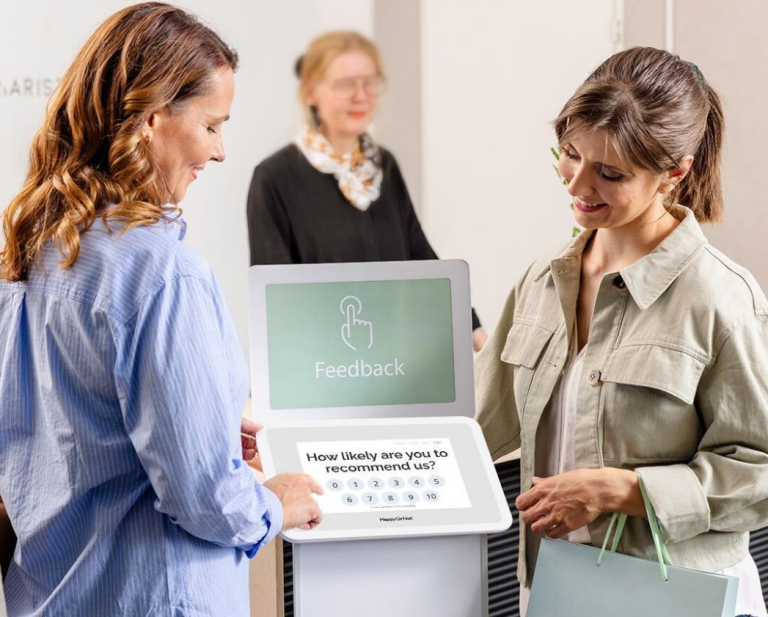What is Net Promoter Score?
Get an accurate NPS score, by asking everyone, not just the people who transact, with HappyOrNot Kiosks
What is Net Promoter Score NPS?
Net Promoter Score measures customer experience but is focused on a customers’ overall perception of your brand and long-term loyalty. It is a specific question you ask your transacting customers but rarely ask people who are just browsing. So rather than focusing on a specific interaction, like CSAT or CES scores, it is focused on your relationship with the organisation. It can help organisations gauge customer loyalty and predict growth potential.
When does NPS make sense? NPS makes sense when you have a close relationship with a customer, and you are often interacting with them. In that case it doesn’t make sense to ask them about their satisfaction after every interaction like CSAT does. Think professional service firms interacting with their customers.
How is a NPS score calculated
A NPS survey is based on asking a prescribed question “On a scale from 0 to 10, how likely are you to recommend this product/company to a friend or colleague?” It uses a scale of 1-10 where promoters are 9’s and 10’s. Passives are those who score you 7-8. Detractors are deemed as unhappy customers who score you 0-6.
The NPS score is calculated by the % of promoters – % of detractors. Neutrals are excluded from the calculation.
NPS scores can range from -100 to 100. A higher score is better, with scores closer to 100 indicating greater customer loyalty and sentiment.

What is a good NPS Score
A good Net Promoter Score (NPS) depends on the industry, but here are general benchmarks:
- Above 0 → More promoters than detractors, meaning your business has a positive reputation.
- Above 20 → A decent score, indicating a healthy customer experience.
- Above 50 → Excellent; your customers are highly satisfied and loyal.
- Above 70 → World-class; only the most customer-centric companies achieve this.
What are some NPS industry averages
Because NPS isn’t generally associated with a specific transaction or experience it can be asked at any time and is often asked as part of an annual or periodic process by an organisation.
HappyOrNot has collected over 1.5 billion feedbacks across many industries enabling it to generate industry averages for NPS. Listed below are the industry averages for key industries:
Services
- Top 5% – NPS 92
- Middle 50% – NPS 63
- Bottom 10% – NPS 19
Healthcare
- Top 5% – NPS 90
- Middle 50% – NPS 68
- Bottom 10% – NPS 33
Transportation
- Top 5% – NPS 88
- Middle 50% – NPS 53
- Bottom 10% – NPS 15
Retail
- Top 5% – NPS 91
- Middle 50% – NPS 70
- Bottom 10% – NPS 29
Technology
- Top 5% – NPS 88
- Middle 50% – NPS 53
- Bottom 10% – NPS 15
Manufacturing
- Top 5% – NPS 93
- Middle 50% – NPS 56
- Bottom 10% – NPS 4
How should I use NPS?
Because NPS isn’t generally associated with a specific transaction or experience it can be asked at any time and is often asked as part of an annual or periodic process by an organisation.
The NPS system is simple and intuitive, but it may lack the depth needed for a full understanding of customer satisfaction. Businesses should complement NPS with additional metrics or surveys to gain more detailed insights. Additionally, some customers may be satisfied with their experience but hesitant to recommend a company, making NPS less reflective of their true sentiment. To address these limitations, it’s essential to use NPS alongside other feedback measures to adopt a holistic approach to measuring customer satisfaction. Other feedback measures includes Customer satisfaction score (CSAT) and Customer Effort Score (CES) which are more focused on a single interaction.
When does NPS make sense? NPS makes sense when you have a close relationship with a customer, and you are often interacting with them. In that case it doesn’t make sense to ask them about their satisfaction after every interaction like CSAT does. Think professional service firms interacting with their customers.
How HappyOrNot can help with NPS

HappyOrNot provides official NPS® surveys both on premises with its Smiley Touch kiosks, as well as online with the Smiley Digital surveys. This enables companies to use real-time customer feedback data to measure their NPS scores and track them over time.
In addition to connecting the “when” and “where”, HappyOrNot can also via demographics capture the “who” of the experience with the feedback.
What makes HappyOrNot unique is that we can ask the people who transact and the people who don’t, we don’t discriminate your customers from your potential customers.
Ready To Boost Your Revenue With Our Customer Feedback Solution?
Empower your business with an industry-leading customer feedback platform. Identify improvement areas, capitalise on growth opportunities, and boost customer loyalty and satisfaction.
